
USS Underhill (DE-682) was a Buckley-class destroyer escort of the United States Navy during World War II. Built in 1943, she served in the Atlantic, the Mediterranean, and the Pacific until her sinking in a suicide attack by a Japanese Kaiten manned torpedo on 24 July 1945.
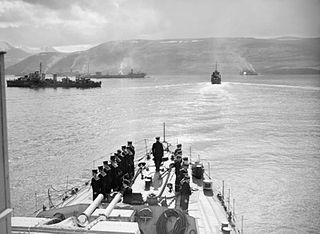
PQ 17 was the code name for an Allied Arctic convoy during the Second World War. On 27 June 1942, the ships sailed from Hvalfjörður, Iceland, for the port of Arkhangelsk in the Soviet Union. The convoy was located by German forces on 1 July, after which it was shadowed continuously and attacked. The First Sea Lord Admiral Dudley Pound, acting on information that German surface units, including the German battleship Tirpitz, were moving to intercept, ordered the covering force built around the Allied battleships HMS Duke of York and the USS Washington away from the convoy and told the convoy to scatter. Because of vacillation by Oberkommando der Wehrmacht, the Tirpitz raid never materialised. The convoy was the first large joint Anglo-American naval operation under British command; in Churchill's view this encouraged a more careful approach to fleet movements.

Operation Pedestal, known in Malta as Il-Konvoj ta' Santa Marija, was a British operation to carry supplies to the island of Malta in August 1942, during the Second World War.

USS Niblack (DD-424), a Gleaves-class destroyer, is the only ship of the United States Navy to be named for Albert Parker Niblack. Niblack became the Director of Naval Intelligence 1 March 1919, and Naval Attache in London 6 August 1920. As vice admiral, he commanded U.S. Naval Forces in European waters from 15 January 1921 to 17 June 1922.

USS Hobson (DD-464/DMS-26), a Gleaves-class destroyer, was the only ship of the United States Navy to be named for Richmond Pearson Hobson, who was awarded the Medal of Honor for actions during the Spanish–American War. He would later in his career attain the rank of rear admiral and go on to serve as a congressman from the state of Alabama.

USS Benson (DD-421) was the lead ship of her class of destroyers in the United States Navy during World War II. She was named for Admiral William S. Benson (1855–1932).

The second USS Lansdale (DD-426) was a Benson-class destroyer in the United States Navy during World War II. She was named for Philip Lansdale.
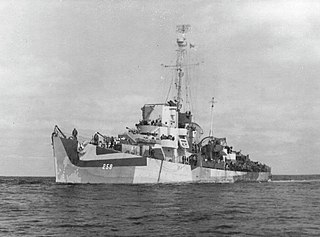
USS Walter S. Brown (DE-258) was an Evarts-class destroyer escort of the United States Navy during World War II. She was engaged in protecting convoys in the North Atlantic and Mediterranean.

Operation Vigorous was a British operation during the Second World War, to escort supply convoy MW11 from the eastern Mediterranean to Malta, which took place from 11 to 16 June 1942. Vigorous was part of Operation Julius, a simultaneous operation with Operation Harpoon from Gibraltar and supporting operations. Sub-convoy MW11c sailed from Port Said (Egypt) on 11 June, to tempt the Italian battlefleet to sail early, use up fuel and be exposed to submarine and air attack. MW11a and MW11b sailed next day from Haifa, Port Said and Alexandria; one ship was sent back because of defects. Italian and German (Axis) aircraft attacked MW11c on 12 June and a damaged ship was diverted to Tobruk, just east of Gazala. The merchant ships and escorts rendezvoused on 13 June. The British plans were revealed unwittingly to the Axis by the US Military Attaché in Egypt, Colonel Bonner Fellers, who reported to Washington, D.C. in "Black"-coded wireless messages; it was later discovered that the Black Code had been broken by the Servizio Informazioni Militare.

Convoy PQ 18 was an Arctic convoy of forty Allied freighters from Scotland and Iceland to Arkhangelsk in the Soviet Union in the war against Nazi Germany. The convoy departed Loch Ewe, Scotland on 2 September 1942, rendezvoused with more ships and escorts at Iceland and arrived at Arkhangelsk on 21 September. An exceptionally large number of escorts was provided by the Royal Navy in Operation EV, including the first escort carrier to accompany an Arctic convoy. Detailed information on German intentions was provided by the code breakers at Bletchley Park and elsewhere, through Ultra signals decrypts and eavesdropping on Luftwaffe wireless communications.

USS Wyffels (DE-6) was an Evarts-class destroyer escort in the United States Navy during World War II.
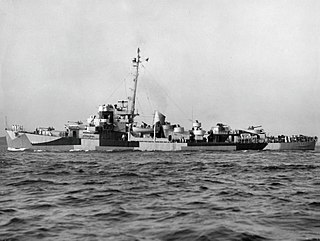
USS Smartt (DE-257) was an Evarts-class destroyer escort of the United States Navy during World War II. She took part in operations in the Atlantic Ocean to protect convoys and other ships from German submarines and fighter aircraft. She performed escort and antisubmarine operations in battle areas before sailing home at the end of the conflict.

USS Swasey (DE-248) was an Edsall-class destroyer escort built for the U.S. Navy during World War II. She served in the Atlantic Ocean the Pacific Ocean and provided destroyer escort protection against submarine and air attack for Navy vessels and convoys.
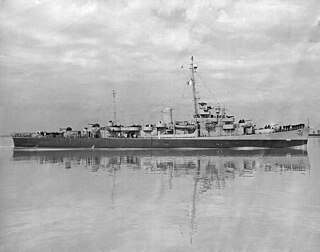
USS Mosley was an Edsall-class destroyer escort built for the U.S. Navy during World War II. She served in the Atlantic Ocean the Pacific Ocean and provided destroyer escort protection against submarine and air attack for Navy vessels and convoys.

USS Wilhoite (DE-397) was an Edsall-class destroyer escort built for the United States Navy during World War II. She served in the Atlantic Ocean and the Pacific Ocean and provided destroyer escort protection against submarine and air attack for Navy vessels and convoys.

USCGC Campbell (WPG-32) was a 327-foot (100 m) Secretary-class United States Coast Guard ship built at the Philadelphia Navy Yard in 1935-1936 and commissioned in 1936. Seven similar "combat cutters" were built and named for secretaries of the United States Treasury.
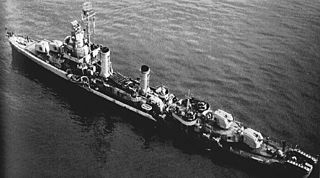
The action off Cape Bougaroun, or the Attack on Convoy KMF-25A was a Luftwaffe action against an Allied naval convoy off the coast of Algeria during World War II. The convoy of American, British, Greek and Dutch ships was attacked on 6 November 1943 by 25 German land-based aircraft. Six Allied vessels were sunk or damaged and six German aircraft were destroyed. German forces achieved a tactical victory, though the Allied warships involved received credit for defending their convoy and reacting to their losses quickly. The quick response led to the rescue of over 6,000 servicemen and civilians without further loss of life.

Destroyer Squadron 7 is a naval unit of the United States Navy stationed in Singapore. It is assigned to the United States Seventh Fleet.

Turbine was the lead ship of her class of eight destroyers built for the Regia Marina during the 1920s. Her name means whirlwind.
World War II was the first war where naval aviation took a major part in the hostilities. Aircraft carriers were used from the start of the war in Europe looking for German merchant raiders and escorting convoys. Offensive operations began with the Norwegian campaign where British carriers supported the fighting on land.




















